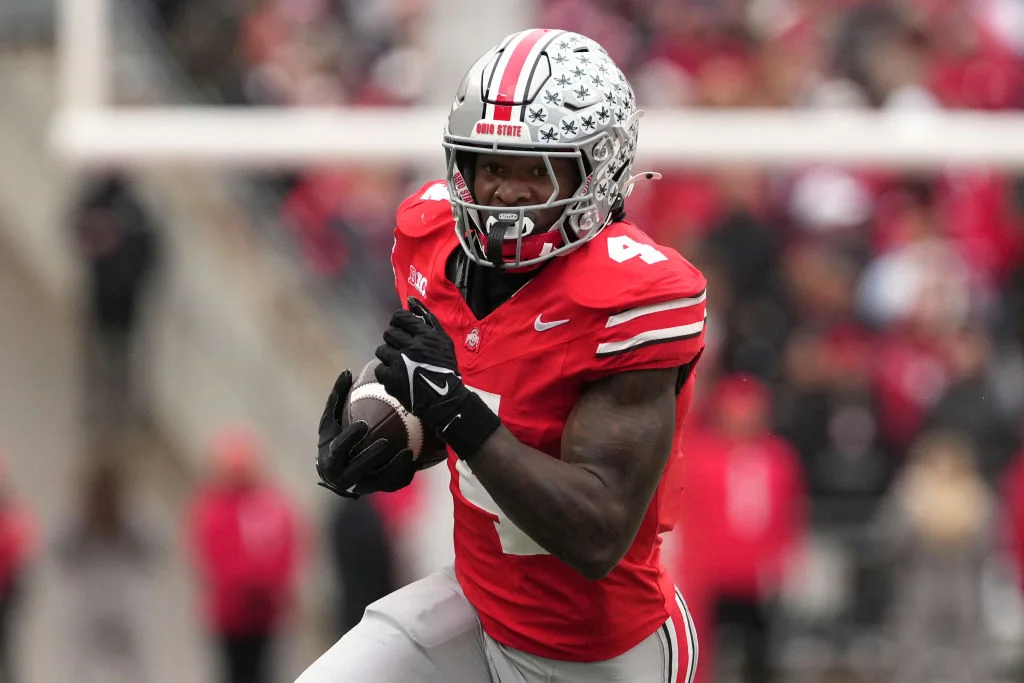In EA Sports’ opinion, Jeremiah Smith is nearly flawless. That’s not hyperbole—it’s the prevailing sentiment around the highly touted wide receiver whose emergence has captured the attention of fans, scouts, and video game developers alike. When a player garners that level of praise from a brand as influential and detail-oriented as EA Sports, it signals something bigger than just potential. It implies that what they see in Smith goes beyond college stardom. They see NFL-ready ability, charisma, and polish that makes him worthy of near-perfection.
Jeremiah Smith has been on the radar for years, but it’s only recently that the conversation around him has taken a sharp turn from “promising young talent” to “possible generational player.” EA Sports, through their meticulous player ratings, animations, and gameplay integration, doesn’t just throw around the word “flawless.” Their player grading and feature design are heavily data-driven, fed by scouting reports, physical metrics, and an army of analysts who spend countless hours comparing real-life traits to digital counterparts. For Smith to be described in such glowing terms by this team means something extraordinary is happening.
Watching Smith on the field tells you most of what you need to know. His frame is ideal, standing at 6’3″ with a wingspan that allows him to high-point the ball in ways that few defenders can contest. That’s just the physical side. Where Smith really begins to separate himself is in the details: the crispness of his route running, the ability to create separation with a subtle shoulder fake or hip sink, and the speed to pull away in the open field. He’s not just a straight-line burner or a jump-ball specialist. He’s the full route tree kind of receiver. He’s equally dangerous catching a quick slant over the middle or stretching the field vertically on a deep post.
EA Sports noticed that. Their video game simulations rely on realism to build immersion and authenticity. A player like Smith forces them to adjust their modeling. How do you code instincts? How do you simulate a receiver’s feel for where the defensive back is, without looking? That’s the kind of problem Smith presents. He’s not just statistically impressive; he performs in ways that make traditional scouting descriptors feel limited. Words like “smooth” and “explosive” begin to feel inadequate when you watch him repeatedly torch secondaries that are doing everything right.
There’s also the polish. Most freshman receivers come in needing time to develop—not just physically, but mentally. They have to learn the pace of the college game, how to study film, how to adjust routes based on coverages. Smith? He looked ready from day one. His transition into the college level was less of a learning curve and more of a smooth glide. The reports from practices and scrimmages all said the same thing: he looked like he belonged—actually, he looked like he was already beyond the college game in some areas.
EA Sports tends to reserve their highest praise for players with the combination of intangibles and intangibles that translate to stardom at the next level. And Smith, by every available measure, fits that mold. But beyond the highlight-reel catches and breakaway speed, what truly sets him apart is how few weaknesses there are to analyze. When trying to determine a player’s rating in EA’s football titles, the dev team and consultants look for flaws to weigh against strengths. They break down speed, acceleration, agility, catching in traffic, awareness, route precision, blocking, release against press coverage—the full catalog of traits. With most players, it’s a process of trade-offs. Maybe they have elite speed but struggle with contested catches. Maybe they have size but lack suddenness. With Jeremiah Smith, the notes read more like a best-case scenario checklist.
Of course, no one is perfect. Even Smith would admit he has room to grow. He’s still young, and while his physical gifts are immense, the jump to NFL defenses will still test him. EA Sports isn’t saying he’s already a Hall of Famer. What they are suggesting is that, among all active or incoming players, he is the closest thing they’ve seen to a model receiver. The idea of “flawlessness” in this context doesn’t mean incapable of error; it means that relative to his peers and stage in development, he’s at the top of the pyramid in every way that matters.
And then there’s the mentality. You don’t get called nearly flawless just by being a freak athlete. You have to carry yourself like a professional, even in amateur status. Smith’s interviews reveal a player with focus and maturity beyond his years. He doesn’t just say the right things—he processes the game like someone who’s been in the system a long time. He talks about leverage, defensive tendencies, play-calling structure, and how he adjusts on the fly. Coaches rave not just about what he does, but how quickly he learns. That’s the kind of brain EA Sports wants to replicate in its AI-controlled players. A receiver who adapts. One who adjusts his route if the corner is sitting in the flat, or throttles down in a zone to give his quarterback an easier target. Smith brings that level of nuance.
It’s also worth noting that EA Sports has a long history of identifying future stars before they explode nationally. Past iterations of their college football and Madden franchises have included rising talents given elevated ratings early in their careers—players who went on to dominate the league. For Smith to be getting that kind of treatment now signals that the company sees him in that same mold. Their attention to detail is what makes their games feel authentic. They don’t just inflate numbers for hype. When they call a player nearly flawless, it’s based on hours of film study, conversations with coaches, and metrics most fans never see.
There’s also the cultural weight that comes with this kind of praise. When EA Sports highlights a player in this way, it elevates them not just in the gaming world but in the broader sports conversation. Smith becomes the face of a generation—a player who younger athletes want to emulate, someone who shows up not just in real highlight reels but as a dominant force in digital ones. That crossover influence is rare and powerful. It takes a certain kind of player to be both a human highlight machine and a digital archetype. Jeremiah Smith is fast becoming both.
And that presence matters. As college football continues to evolve—with NIL deals, expanded playoffs, and increasingly complex media coverage—players like Smith become central figures. He represents what the modern wide receiver looks like: big, fast, technical, and intelligent. EA Sports capturing his likeness and skill set with such high praise is also a way of capturing the future of the game itself. He’s not just one prospect among many. He’s the prototype.
There’s a unique feedback loop at work here, too. Smith’s excellence on the field earns him high marks in the game. Then, fans play the game and become more familiar with his name, more excited about his performances, more tuned in to his progress. It builds a sense of inevitability—that Smith is not just going to make it, but that he’s destined to be great. It’s not a fair expectation, necessarily, but it’s one that’s already taking shape.
Ultimately, what EA Sports is saying when they describe Jeremiah Smith as nearly flawless is that he’s the kind of player who breaks their molds. He’s the reason ratings caps feel limiting. He’s the reason new animations get built, why catch logic needs updating, why defenders need smarter AI to account for receivers with his level of talent. He’s not just part of the next wave—he might be the standard it’s measured against.
And maybe, just maybe, that’s what makes him different. Not just the stats. Not just the highlights. But the idea that when you see him play, you’re watching something that’s hard to categorize. You’re watching someone who forces people—coaches, players, fans, and yes, video game developers—to rethink what’s possible at his position. In a sport full of stars, that’s about as close to flawless as it gets.



